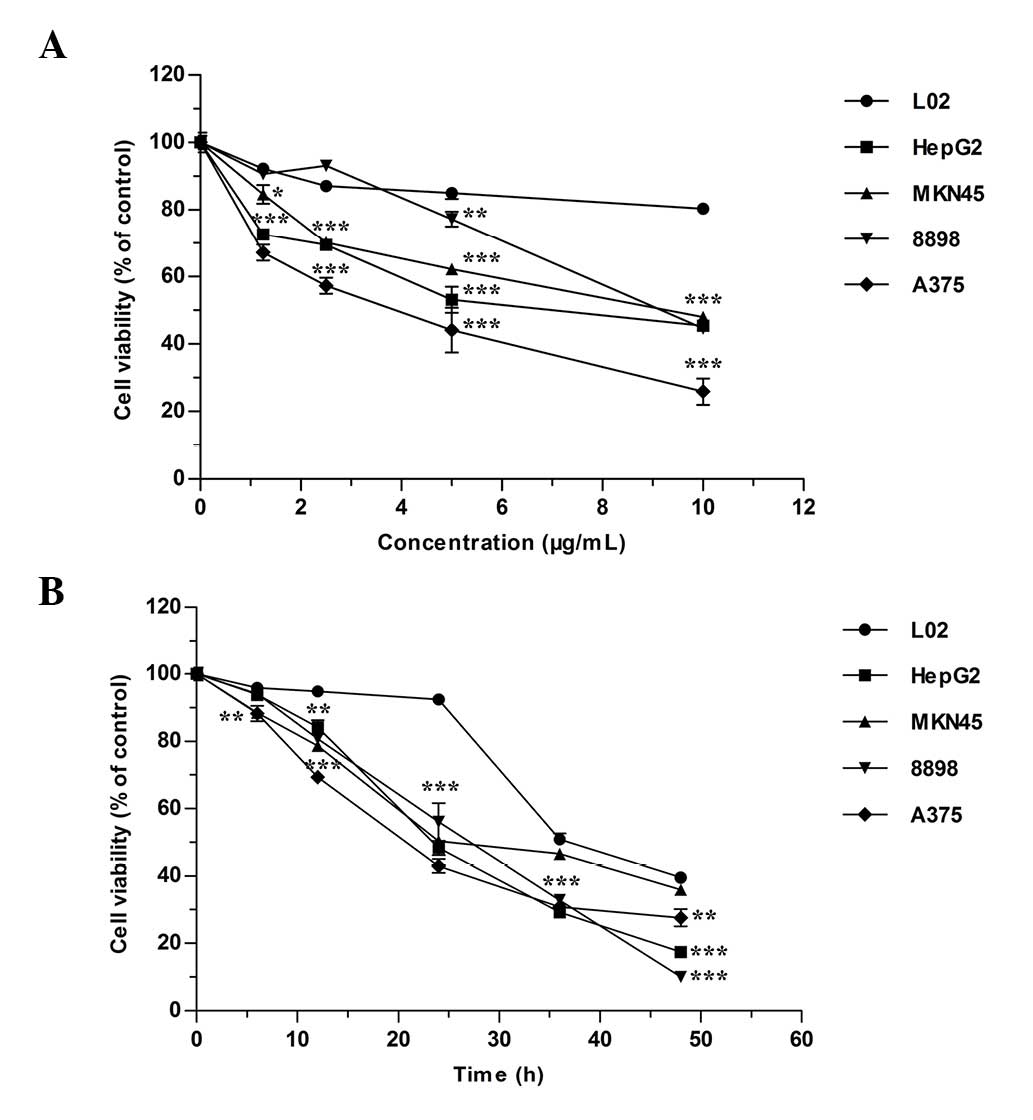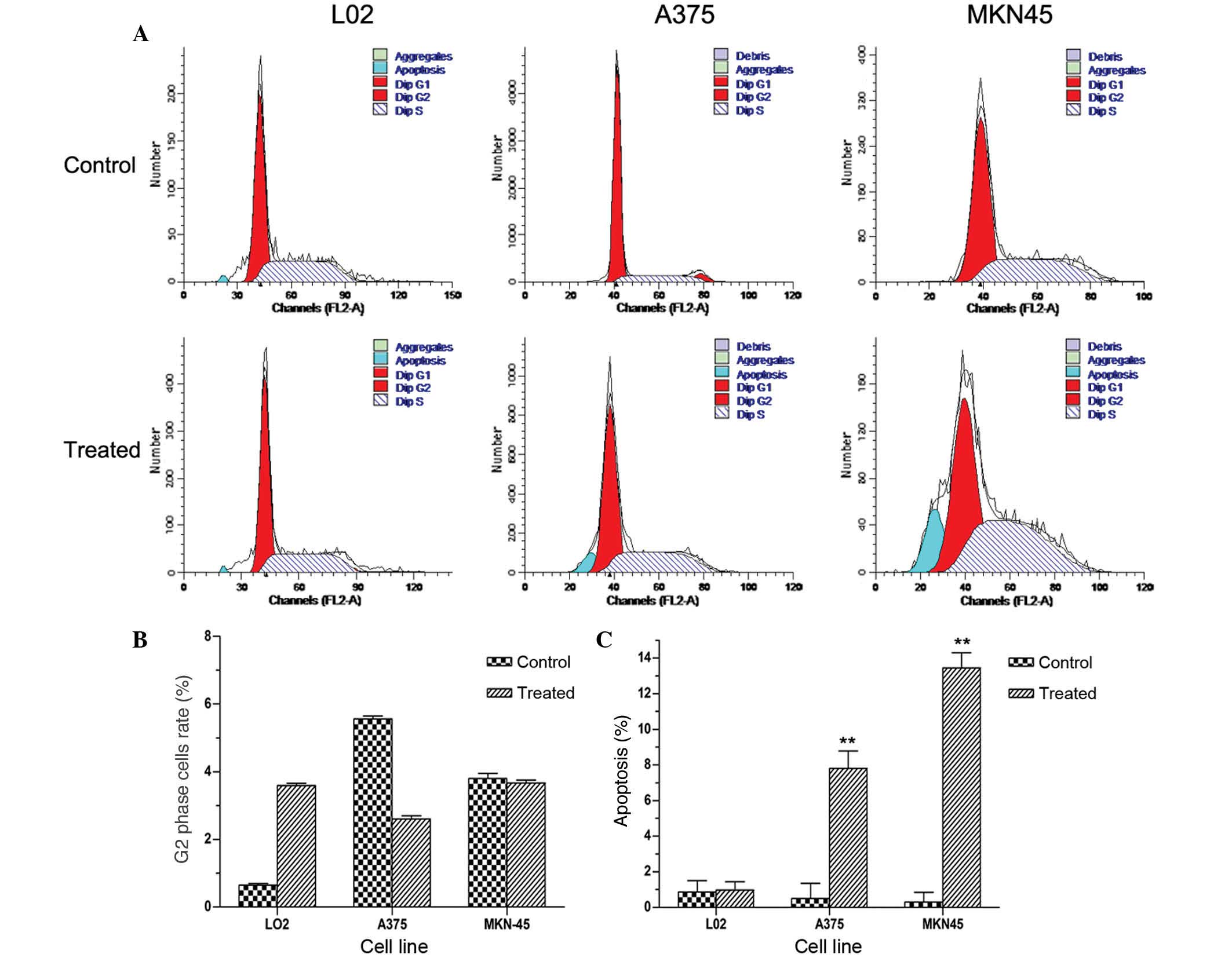|
1
|
Nakagawa Y, Akao Y, Morikawa H, et al:
Arsenic trioxide-induced apoptosis through oxidative stress in
cells of colon cancer cell lines. Life Sci. 70:2253–2269. 2002.
View Article : Google Scholar : PubMed/NCBI
|
|
2
|
Ramanathan K, Anusuyadevi M, Shila S and
Panneerselvam C: Ascorbic acid and alpha-tocopherol as potent
modulators of apoptosis on arsenic induced toxicity in rats.
Toxicol Lett. 156:297–306. 2005. View Article : Google Scholar : PubMed/NCBI
|
|
3
|
Waxman S and Anderson KC: History of the
development of arsenic derivatives in cancer therapy. Oncologist.
6(Suppl 2): 3–10. 2001. View Article : Google Scholar : PubMed/NCBI
|
|
4
|
Niu C, Yan H, Yu T, et al: Studies on
treatment of acute promyelocytic leukemia with arsenic trioxide:
remission induction, follow-up, and molecular monitoring in 11
newly diagnosed and 47 relapsed acute promyelocytic leukemia
patients. Blood. 94:3315–3324. 1999.PubMed/NCBI
|
|
5
|
Murgo AJ: Clinical trials of arsenic
trioxide in hematologic and solid tumors: overview of the National
Cancer Institute Cooperative Research and Development Studies.
Oncologist. 6(Suppl 2): 22–28. 2001. View Article : Google Scholar : PubMed/NCBI
|
|
6
|
Zheng J, Deng YP, Lin C, Fu M, Xiao PG and
Wu M: Arsenic trioxide induces apoptosis of HPV16 DNA-immortalized
human cervical epithelial cells and selectively inhibits viral gene
expression. Int J Cancer. 82:286–292. 1999. View Article : Google Scholar : PubMed/NCBI
|
|
7
|
Shen ZY, Zhang Y, Chen JY, et al:
Intratumoral injection of arsenic to enhance antitumor efficacy in
human esophageal carcinoma cell xenografts. Oncol Rep. 11:155–159.
2004.
|
|
8
|
Emadi A and Gore SD: Arsenic trioxide - An
old drug rediscovered. Blood Rev. 24:191–199. 2010. View Article : Google Scholar : PubMed/NCBI
|
|
9
|
Rojewski MT, Baldus C, Knauf W, Thiel E
and Schrezenmeier H: Dual effects of arsenic trioxide
(As2O3) on non-acute promyelocytic leukaemia
myeloid cell lines: induction of apoptosis and inhibition of
proliferation. Br J Haematol. 116:555–563. 2002. View Article : Google Scholar : PubMed/NCBI
|
|
10
|
Park WH, Seol JG, Kim ES, et al: Arsenic
trioxide-mediated growth inhibition in MC/CAR myeloma cells via
cell cycle arrest in association with induction of cyclin-dependent
kinase inhibitor, p21, and apoptosis. Cancer Res. 60:3065–3071.
2000.PubMed/NCBI
|
|
11
|
Zhong F, Zhang S, Shao C, Yang J and Wu X:
Arsenic trioxide inhibits cholangiocarcinoma cell growth and
induces apoptosis. Pathol Oncol Res. 16:413–420. 2010. View Article : Google Scholar
|
|
12
|
Lu DP, Qiu JY, Jiang B, et al:
Tetra-arsenic tetra-sulfide for the treatment of acute
promyelocytic leukemia: a pilot report. Blood. 99:3136–3143. 2002.
View Article : Google Scholar : PubMed/NCBI
|
|
13
|
Wang L, Zhou GB, Liu P, et al: Dissection
of mechanisms of Chinese medicinal formula Realgar-Indigo naturalis
as an effective treatment for promyelocytic leukemia. Proc Natl
Acad Sci USA. 105:4826–4831. 2008. View Article : Google Scholar : PubMed/NCBI
|
|
14
|
Zhang QY, Mao JH, Liu P, et al: A systems
biology understanding of the synergistic effects of arsenic sulfide
and Imatinib in BCR/ABL-associated leukemia. Proc Natl Acad Sci
USA. 106:3378–3383. 2009. View Article : Google Scholar : PubMed/NCBI
|
|
15
|
Chen S, Fang Y, Ma L, Liu S and Li X:
Realgar-induced apoptosis and differentiation in all-trans retinoic
acid (ATRA)-sensitive NB4 and ATRA-resistant MR2 cells. Int J
Oncol. 40:1089–1096. 2012.
|
|
16
|
Yin T, Wu YL, Sun HP, et al: Combined
effects of As4S4 and imatinib on chronic
myeloid leukemia cells and BCR-ABL oncoprotein. Blood.
104:4219–4225. 2004. View Article : Google Scholar : PubMed/NCBI
|
|
17
|
Wu J, Shao Y, Liu J, Chen G and Ho PC: The
medicinal use of realgar (As4S4) and its
recent development as an anticancer agent. J Ethnopharmacol.
135:595–602. 2011. View Article : Google Scholar : PubMed/NCBI
|
|
18
|
Lu DP and Wang Q: Current study of APL
treatment in China. Int J Hematol. 76(Suppl 1): 316–318. 2002.
View Article : Google Scholar : PubMed/NCBI
|
|
19
|
Majno G and Joris I: Apoptosis, oncosis,
and necrosis. An overview of cell death. Am J Pathol. 146:3–15.
1995.PubMed/NCBI
|
|
20
|
McConkey DJ and Orrenius S: Signal
transduction pathways in apoptosis. Stem Cells. 14:619–631. 1996.
View Article : Google Scholar : PubMed/NCBI
|
|
21
|
Hunot S and Flavell RA: Apoptosis. Death
of a monopoly? Science. 292:865–866. 2001. View Article : Google Scholar : PubMed/NCBI
|
|
22
|
Hengartner M: Apoptosis. Death by crowd
control. Science. 281:1298–1299. 1998. View Article : Google Scholar : PubMed/NCBI
|
|
23
|
Ashkenazi A and Dixit VM: Death receptors:
signaling and modulation. Science. 281:1305–1308. 1998. View Article : Google Scholar : PubMed/NCBI
|
|
24
|
McIlwain DR, Berger T and Mak TW: Caspase
functions in cell death and disease. Cold Spring Harb Perspect
Biol. 5:a0086562013. View Article : Google Scholar : PubMed/NCBI
|
|
25
|
Smith KA: Interleukin-2: inception,
impact, and implications. Science. 240:1169–1176. 1988. View Article : Google Scholar : PubMed/NCBI
|
|
26
|
Sakaguchi S, Sakaguchi N, Asano M, Itoh M
and Toda M: Immunologic self-tolerance maintained by activated T
cells expressing IL-2 receptor alpha-chains (CD25). Breakdown of a
single mechanism of self-tolerance causes various autoimmune
diseases. J Immunol. 155:1151–1164. 1995.PubMed/NCBI
|
|
27
|
McAdam AJ, Pulaski BA, Harkins SS, Hutter
EK, Lord EM and Frelinger JG: Synergistic effects of co-expression
of the TH1 cytokines IL-2 and IFN-gamma on generation of murine
tumor-reactive cytotoxic cells. Int J Cancer. 61:628–634. 1995.
View Article : Google Scholar : PubMed/NCBI
|
|
28
|
Sakthivel KM and Guruvayoorappan C: Acacia
ferruginea inhibits tumor progression by regulating inflammatory
mediators-(TNF-α, iNOS, COX-2, IL-1β, IL-6, IFN-γ, IL-2, GM-CSF)
and pro-angiogenic growth factor-VEGF. Asian Pac J Cancer Prev.
14:3909–3919. 2013. View Article : Google Scholar
|
|
29
|
Wang LW, Shi YL, Wang N, Gou BD, Zhang TL
and Wang K: Association of oxidative stress with realgar-induced
differentiation in human leukemia HL-60 cells. Chemotherapy.
55:460–467. 2009. View Article : Google Scholar : PubMed/NCBI
|
|
30
|
Wang N, Wang LW, Gou BD, Zhang TL and Wang
K: Realgar-induced differentiation is associated with MAPK pathways
in HL-60 cells. Cell Biol Int. 32:1497–1505. 2008. View Article : Google Scholar : PubMed/NCBI
|














